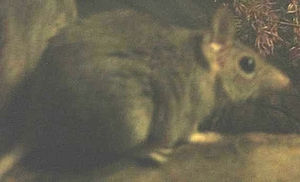Fawn antechinus
| Fawn antechinus[1] | |
|---|---|

| |
| Scientific classification | |
| Kingdom: | Animalia |
| Phylum: | Chordata |
| Class: | Mammalia |
| Infraclass: | Marsupialia |
| Order: | Dasyuromorphia |
| Family: | Dasyuridae |
| Genus: | Antechinus |
| Species: | A. bellus
|
| Binomial name | |
| Antechinus bellus (Thomas, 1904)
| |

| |
| Distribution of the fawn antechinus | |
The fawn antechinus (Antechinus bellus) is a species of small carnivorous marsupial found in northern Australia. It is the only Antechinus to be found in the Northern Territory and has a patchy, restricted range.
Taxonomy
The earliest scientific collection of a fawn antechinus was made by John T. Tunney,[3] and the first zoological description was made in 1904 by the renowned biologist Oldfield Thomas, who gave it the species name bellus, meaning beautiful.[4] It has never been confused with other species.
It is a member of the family Dasyuridae and of the genus Antechinus (meaning "hedgehog-equivalent"), which has nine other members.
Description
The fawn antechinus is unique among antechinuses, being considerably paler than many of its relatives. It is a light grey colour and is distinguished from the only other similar species in the area where it lives (the sandstone dibbler and the red-cheeked dunnart) by its larger size and paler colouring. It is insectivorous and, like many of its relatives, all of the males die after the breeding season.[5]
The fawn antechinus has a breeding season during August. Young are born in September–October in litters of up to ten, and are usually weaned by January.[5]
Distribution and habitat
The fawn antechinus is found in the Top End of the Northern Territory, where it is fairly common.[4] It inhabits tall, fairly open forest in the tropics.
In Aboriginal language and culture
The Kunwinjku people of western Arnhem Land call this animal mulbbu, as they do many small marsupials and rodents.[6][7][8]
References
- ^ Groves, C. P. (2005). Wilson, D. E.; Reeder, D. M. (eds.). Mammal Species of the World: A Taxonomic and Geographic Reference (3rd ed.). Baltimore: Johns Hopkins University Press. p. 29. ISBN 0-801-88221-4. OCLC 62265494.
- ^ "IUCN World Conservation congress, 2016". Archived from the original on 8 September 2016. Retrieved 9 September 2016.
- ^ Kristofer M. Helgen; Roberto Portela Miguez; James Kohen; Lauren Helgen (2012). "Twentieth century occurrence of the Long-Beaked Echidna Zaglossus bruijnii in the Kimberley region of Australia". ZooKeys (255): 103–132. doi:10.3897/zookeys.255.3774. PMC 3560862. PMID 23459668.
- ^ a b Calaby, J.H. (1995). "Fawn Antechinus". In Strahan, Ronald (ed.). The Mammals of Australia. Reed Books. pp. 85–86.
- ^ a b Menkhorst, Peter (2001). A Field Guide to the Mammals of Australia. Oxford University Press. p. 54.
- ^ Garde, Murray. "mulbbu". Bininj Kunwok Online Dictionary. Bininj Kunwok Regional Language Centre. Retrieved 31 October 2021.
- ^ Goodfellow, D. (1993). Fauna of Kakadu and the Top End. Wakefield Press. p. 21. ISBN 1862543062.
- ^ "Various Rock Dwelling Dasyurids". Bininj Kunwok Names for Plants and Animals. Bininj Kunwok Language Project. Retrieved 31 October 2021.
Error: "Q135411" is not a valid Wikidata entity ID.
- Articles with short description
- Use dmy dates from January 2013
- IUCN Red List vulnerable species
- Articles with 'species' microformats
- Taxonbars desynced from Wikidata
- Taxonbar pages requiring a Wikidata item
- Taxonbars with invalid from parameters
- Taxonbars without secondary Wikidata taxon IDs
- Dasyuromorphs
- Mammals of the Northern Territory
- Marsupials of Australia
- Mammals described in 1904
- Taxa named by Oldfield Thomas
